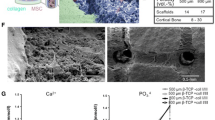Abstract
Over the last 20 years, significant progress has been made in the development of immunodeficient mouse models that now represents the gold standard tool in stem cell biology research. The latest major improvement has been the use of biomaterials in these xenogeneic mouse models to generate human “bone marrow like” tissues, which not only provides a more relevant xenograft model but can also potentially enable us to delineate the interactions that are specific between human bone marrow cells. There are a number of biomaterials and strategies to create humanized niches in immunodeficient mouse models, and the methods can also differ significantly among various research institutes. Here, we describe a protocol to create a humanized 3D collagen-based scaffold human niche in immunodeficient mouse model(s). This humanized in vivo model provides a powerful technique for understanding the human BM microenvironment and the role it plays in the regulation of normal as well as malignant hematopoiesis.
Access this chapter
Tax calculation will be finalised at checkout
Purchases are for personal use only
Similar content being viewed by others
References
Velten L et al (2017) Human haematopoietic stem cell lineage commitment is a continuous process. Nat Cell Biol 19(4):271–281
Ramasamy SK et al (2016) Regulation of hematopoiesis and osteogenesis by blood vessel-derived signals. Annu Rev Cell Dev Biol 32:649–675
Raynaud CM et al (2013) Endothelial cells provide a niche for placental hematopoietic stem/progenitor cell expansion through broad transcriptomic modification. Stem Cell Res 11(3):1074–1090
Yu VW, Scadden DT (2016) Heterogeneity of the bone marrow niche. Curr Opin Hematol 23(4):331–338
Batsivari A et al (2020) Dynamic responses of the haematopoietic stem cell niche to diverse stresses. Nat Cell Biol 22(1):7–17
Hogan CJ et al (1997) Engraftment and development of human CD34+-enriched cells from umbilical cord blood in NOD/LtSz-scid/scid mice. Blood 90(1):85–96
Nicolini FE et al (2004) NOD/SCID mice engineered to express human IL-3, GM-CSF and steel factor constitutively mobilize engrafted human progenitors and compromise human stem cell regeneration. Leukemia 18(2):341–347
Ito M et al (2002) NOD/SCID/gamma(c)(null) mouse: an excellent recipient mouse model for engraftment of human cells. Blood 100(9):3175–3182
Traggiai E et al (2004) Development of a human adaptive immune system in cord blood cell-transplanted mice. Science 304(5667):104–107
Ishikawa F et al (2005) Development of functional human blood and immune systems in NOD/SCID/IL2 receptor {gamma} chain(null) mice. Blood 106(5):1565–1573
Rongvaux A et al (2014) Development and function of human innate immune cells in a humanized mouse model. Nat Biotechnol 32(4):364–372
Cosgun KN et al (2014) Kit regulates HSC engraftment across the human-mouse species barrier. Cell Stem Cell 15(2):227–238
Bonnet D, Dick JE (1997) Human acute myeloid leukemia is organized as a hierarchy that originates from a primitive hematopoietic cell. Nat Med 3(7):730–737
Rouault-Pierre K et al (2017) Preclinical modeling of myelodysplastic syndromes. Leukemia 31(12):2702–2708
Mian SA et al (2015) SF3B1 mutant MDS-initiating cells may arise from the haematopoietic stem cell compartment. Nat Commun 6:10004
Anjos-Afonso F et al (2013) CD34(−) cells at the apex of the human hematopoietic stem cell hierarchy have distinctive cellular and molecular signatures. Cell Stem Cell 13(2):161–174
Goardon N et al (2011) Coexistence of LMPP-like and GMP-like leukemia stem cells in acute myeloid leukemia. Cancer Cell 19(1):138–152
Clappier E et al (2011) Clonal selection in xenografted human T cell acute lymphoblastic leukemia recapitulates gain of malignancy at relapse. J Exp Med 208(4):653–661
Place ES, Evans ND, Stevens MM (2009) Complexity in biomaterials for tissue engineering. Nat Mater 8(6):457–470
Ratner BD (2019) Biomaterials: been there, done that, and evolving into the future. Annu Rev Biomed Eng 21:171–191
Abarrategi A et al (2017) Versatile humanized niche model enables study of normal and malignant human hematopoiesis. J Clin Invest 127(2):543
Reinisch A et al (2016) A humanized bone marrow ossicle xenotransplantation model enables improved engraftment of healthy and leukemic human hematopoietic cells. Nat Med 22(7):812–821
Acknowledgments
The authors acknowledge the funding received from Wellcome Trust (FC0010045), MRC (FC0010045), and CRUK (FC0010045) through The Francis Crick Institute; and Blood Cancer UK for supporting this work.
Author information
Authors and Affiliations
Corresponding author
Editor information
Editors and Affiliations
Rights and permissions
Copyright information
© 2021 Springer Science+Business Media, LLC, part of Springer Nature
About this protocol
Cite this protocol
Mian, S.A., Bonnet, D. (2021). Engraftment of Human Hematopoietic Cells in Biomaterials Implanted in Immunodeficient Mouse Models. In: Espéli, M., Balabanian, K. (eds) Bone Marrow Environment. Methods in Molecular Biology, vol 2308. Humana, New York, NY. https://doi.org/10.1007/978-1-0716-1425-9_18
Download citation
DOI: https://doi.org/10.1007/978-1-0716-1425-9_18
Published:
Publisher Name: Humana, New York, NY
Print ISBN: 978-1-0716-1424-2
Online ISBN: 978-1-0716-1425-9
eBook Packages: Springer Protocols




